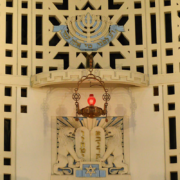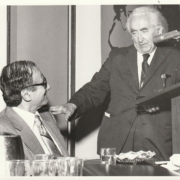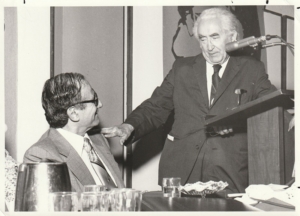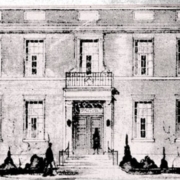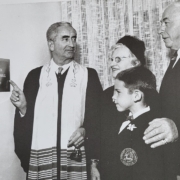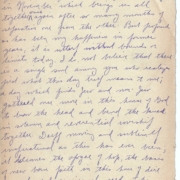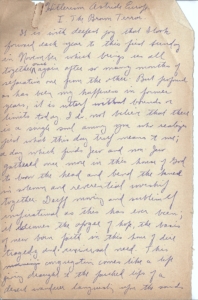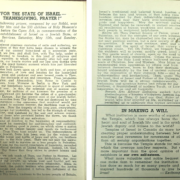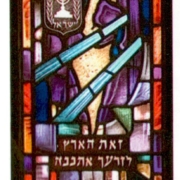Remembering Heinz Warschauer z”l
By Ruth Ellen Greenwood, member of Holy Blossom Temple Archives Committee
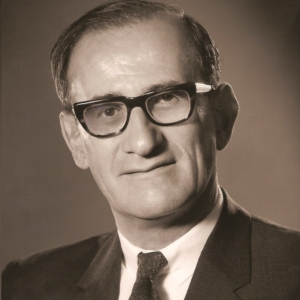 Heinz Warschauer was born in 1913 in Berlin, Germany and educated in public school and university there. He studied under Rabbi Leo Baeck and was a leader of the German Jewish Youth Movement of Berlin. Political journalism and teaching interested him all his life. In 1938, following Kristallnacht, he was interned in Buchenwald concentration camp. In 1939, he managed to get to England, and from there to Canada in 1940. Ironically, he was sent to an internment camp in Sherbrooke, Quebec as a German enemy alien.
Heinz Warschauer was born in 1913 in Berlin, Germany and educated in public school and university there. He studied under Rabbi Leo Baeck and was a leader of the German Jewish Youth Movement of Berlin. Political journalism and teaching interested him all his life. In 1938, following Kristallnacht, he was interned in Buchenwald concentration camp. In 1939, he managed to get to England, and from there to Canada in 1940. Ironically, he was sent to an internment camp in Sherbrooke, Quebec as a German enemy alien.
Upon his release, Heinz began his studies at the University of Toronto where he earned a Masters Degree in Modern History and a Bachelor of Social Work. Starting as a part time teacher at Holy Blossom Religious School, Heinz became the full time Director of Education in 1947, a position he held until his retirement in 1976. Among his major contributions to Jewish education were curriculum development and the use of group work in Religious School and Adult Education. Heinz also created a Post-Confirmation Program which included a teacher training program and a club leadership program. He wrote a comprehensive account of the history of Holy Blossom Temple, and he authored the grade 9 Religious School syllabus of UAHC (now URJ).
In 1960, Heinz was the first Canadian elected as President of the National Association of Temple Educators. From 1967 to 1976, he was member of the Commission on Jewish Education of the Reform Movement. A member of the faculty of NFTY (National Federation of Temple Youth), Heinz was made a lifetime member in 1971. He also inaugurated camp weekends for Junior and Senior High School students and encouraged them to go to the Reform Camps in the United States prior to the establishment of Camp George in Muskoka, Ontario. Heinz was an ardent Zionist and maintained a lifelong interest in Middle Eastern Affairs.
He was always Heinz to everyone – never Mr. Warschauer – just Heinz, and we all knew who we were talking about. He was a unique and unforgettable individual who left a profound and lasting impact on all who studied and worked with him.
As he explained in his own words, “I am a teacher, a group worker, but not specifically a religious educator . . . I would develop a ‘Centre’ for our children as a proper group work agency . . . I would concern myself with the children as people rather than merely vessels to be filled with knowledge.”
He told the Confirmation Class of 1961, “. . . religion provides for constant challenge and assurance through its ‘seasons of gladness,’ its holy days, and its call to learning. It also provides for fellowship, for Judaism is not the possession of the hermit, but of the ‘Chevra’, the group, the brotherhood, which experiences, learns, suffers at times and eventually rejoices – together! ‘Hinnay Mah Tov Umah Na-eem!’”
When Heinz retired in 1976, Joe Kronick z”l wrote, “I probably learned more from him about how to work with people, how to sidestep conflict while at the same time ‘diving in’ head first. There was no compromising on the quality of the educational process . . . He and everything he touched have enjoyed a seal of quality approval . . . the Young Couples Club, Adult Education, Experimental Programs, the Youth Activities Program, All-Day Blitzes, and the placement of students from the School of Social Work. In essence, anything that touched upon the growth and change and identification of people with the Temple and all that it stood for, were part and parcel of Heinz’s driving energy.”
Rabbi Plaut z”l wrote about Heinz, “ To me he was not only unforgettable, he was also inspiration, support, and best of all a friend. . . . He was an irascible bachelor and a passionate educator and was often totally unpredictable. . . . He questioned and taught his students to question. He considered social commitment and action an ineluctable part of the religious quest. He believed in standards – and once the curriculum was set he demanded of his students that they achieve its goals. . . . He was a master teacher. For him there were no children that mattered, there was only the child. Teachers en masse didn’t count, but the individual teacher did. He was a historian at heart: the knowledge of one’s roots was essential to him and he loved to teach history. . . when in Germany, he was interned because he was a Jew and in England because he was a German. The double tension deeply affected his later outlook on life and made him doubly committed to the exploration of his identity and the firming up of the commitment to which he gave his best years. . . The thousands who not only respected him but considered him their spiritual mentor bear vivid testimony to the possibility of teaching as one of the greatest professions.”
I was fortunate to reap all the benefits of being a student at Holy Blossom Religious School when Heinz was the Director of Education. After Confirmation, I enrolled in his student teacher training program. Heinz had enough faith in me to allow me to split the Thursday afternoon teacher training seminars with my practice schedule for the Oakwood Collegiate Senior Orchestra. I left practice half an hour early and arrived half an hour late for the seminar. And because Heinz believed in me and validated my commitment to both activities, I became a successful teacher and enjoyed a long career in the best profession there is – preparing young individuals to take up their responsibilities when they become the adults of our world. Heinz always saw the individual whether a student, a student teacher, or a teacher. He always encouraged group work as a method for achieving the best results whatever the project. Heinz had no children and no family: the students of Holy Blossom Religious School were his children, and the members of Holy Blossom Temple were his family. May his memory forever be for a blessing.
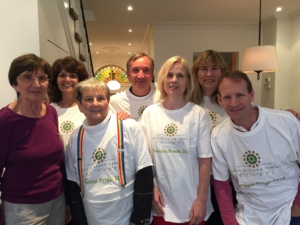 Two treasures in Holy Blossom’s archives from that era are a special hand-stitched quilt and rainbow suspenders. The late Sybil Geller created the colourful quilt in honour of Yale Aaron Lampe, her son-in-law’s brother. Yale died in 1991, relatively early, and the family wanted to bring attention to the people behind the statistics. The rainbow suspenders were worn at the Pride Parade in 2015 by the late Nancy Ruth, a former president of the temple.
Two treasures in Holy Blossom’s archives from that era are a special hand-stitched quilt and rainbow suspenders. The late Sybil Geller created the colourful quilt in honour of Yale Aaron Lampe, her son-in-law’s brother. Yale died in 1991, relatively early, and the family wanted to bring attention to the people behind the statistics. The rainbow suspenders were worn at the Pride Parade in 2015 by the late Nancy Ruth, a former president of the temple.
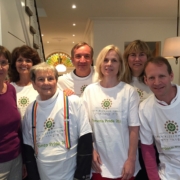
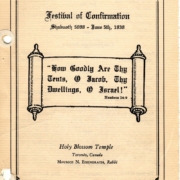
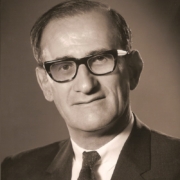
 Heinz Warschauer was born in 1913 in Berlin, Germany and educated in public school and university there. He studied under Rabbi Leo Baeck and was a leader of the German Jewish Youth Movement of Berlin. Political journalism and teaching interested him all his life. In 1938, following Kristallnacht, he was interned in Buchenwald concentration camp. In 1939, he managed to get to England, and from there to Canada in 1940. Ironically, he was sent to an internment camp in Sherbrooke, Quebec as a German enemy alien.
Heinz Warschauer was born in 1913 in Berlin, Germany and educated in public school and university there. He studied under Rabbi Leo Baeck and was a leader of the German Jewish Youth Movement of Berlin. Political journalism and teaching interested him all his life. In 1938, following Kristallnacht, he was interned in Buchenwald concentration camp. In 1939, he managed to get to England, and from there to Canada in 1940. Ironically, he was sent to an internment camp in Sherbrooke, Quebec as a German enemy alien.